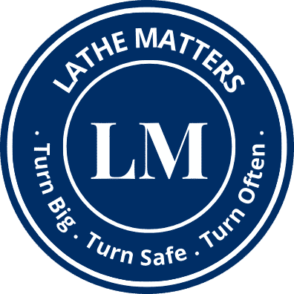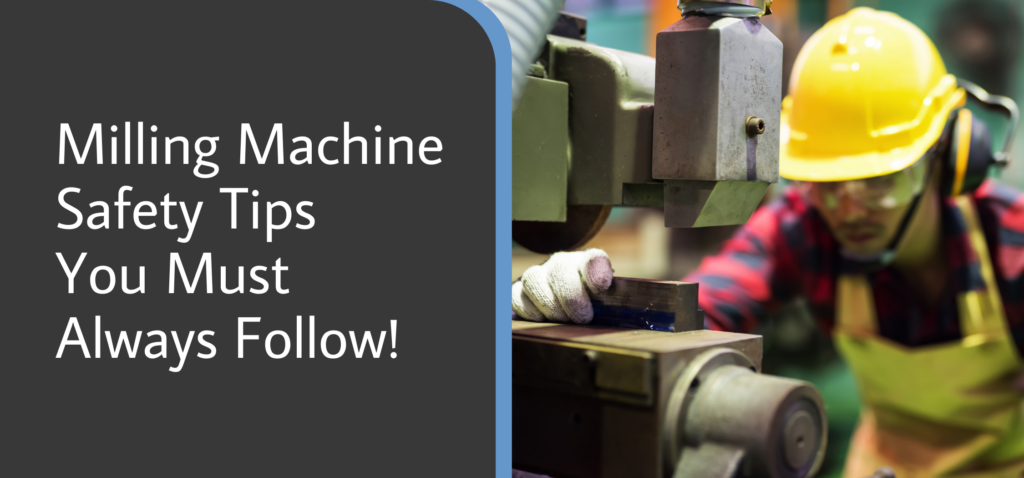Disclaimer: As an Amazon affiliate, I may earn a small percentage from qualifying purchases. This is at no extra cost to you. Learn more here.
Last Updated on March 1, 2023 by Charles Wilson
If you’re machining a workpiece on a mill, the last thing you want is to cut yourself. Accidents happen, but it’s the operator’s job to do everything they can to avoid injuries.
Injuries can occur when operating milling machines. This makes it vital to follow safety precautions while in the workshop.
Milling operators should practice safe work principles to avoid injuring themselves and their colleagues. Here’s what you need to know about milling machine safety.
Important Milling Machine Precautions to Remember

Remember to follow these safety tips to avoid injury in the workshop.
1) Wear The Appropriate PPE
Before I move on to the tools and which cutter you need, my first safety tip involves wearing the correct equipment.
All operators should be wearing their PPE (Personal Protective Equipment) appropriate for the materials they’re machining, but the basic PPE items are as follows:
- Well-fitting, non-flowy clothing
- Safety glasses
- Closed-toe work shoes
You can also wear respirators to keep out fine dust and an apron to keep your tools and wrenches handy.
2) Hold Milling Cutters Safely
A milling cutter is very sharp and can injure you if handled incorrectly. Don’t pick up cutting tools barehanded. Use a cloth, paper towel, or gloves instead.
Remember to remove your gloves before turning the milling machine on, which I’ll discuss later.
3) Use Lifting Equipment
Don’t strain yourself if you’re machining a heavy work piece and need to move it. Grab a hoist to make the job easier.
When using the hoist, also remember to follow safety procedures. Check its ropes or chains for any damage, and replace them if needed.
4) Keep the Milling Machine Free of Obstructions
Before you start cutting material, check the milling machine table first. You should only see your cutter, the vise, and the stock to be machined.
Any spare wrenches or other tools should be removed from the milling table for your safety.
5) Keep Your Hair and Clothes Securely Fastened
A milling machine spindle is designed to run at high speed and can grab any loose material that gets in its path. This includes your hair and clothing.
If you have long hair, tie it back and down to ensure it doesn’t swing near the cutter. Also, ensure you wear well-fitting short-sleeved clothes that won’t slip near the cutter.
Once those sharp cutters start rotating, you’d better hope your clothes don’t get in the way!
6) Ensure All the Guards Are in Place
Milling machines typically have guards to stop wood chips and other flying debris from hitting you.
They’re a critical safety feature, so ensure they’re in place before you turn the power on. A proper guard should be in an appropriate position.
This means the guard should be tamper-proof but not restrict your operator’s access to the milling machine and let you grease the machine without additional difficulty.
What to Check Before Operating a Milling Machine

Proper direction and attention can save you the possibility of injury even before turning on your milling machine.
Put your cutter away now, and look at your mill before turning it on. Ask yourself these questions first.
1) Is Everything Set to a Neutral Position?
You can’t start cutting material yet! First, check all of the feed screws on your milling machine. They should all be set to a neutral position.
It’s important to keep all your feed screws neutral before milling, so your cutter doesn’t get damaged.
2) Is the Cutter Rotating in the Right Direction?
Before you bring the workpiece toward the cutter, ensure it’s rotating in the proper direction.
You don’t want to bring your stock to the machine only to see the cutter spinning in the opposite direction. If your cutting tool isn’t rotating correctly, stop the machine.
Check the spindle and tool separately for any issues.
3) Are Your Cutters Sharpened Correctly?
Before you start working on any stock, check the cutter you’re holding. It should be sharp and in good condition.
A blunt cutter can break during operation or ruin the surface finish of your workpiece, so it’s vital to keep them sharpened.
4) Is the Floor Around the Milling Machine Clean?
The rapid movement in machining will typically create debris and chips, which can accumulate on the floor around your mill.
Then there’s the grease and lubricant that all machines need. This debris can create an unsafe working environment, so use a brush or shop vacuum to remove all those chips.
5) Is the Workpiece Properly Secured?
The mill spindle may be responsible for holding your cutters and other tools, but it needs to be kept secure while the mill’s running. This is where your machine’s vise comes in.
Your workpiece must be securely in a vise to prevent it from dislodging or flying out.
Once you’re certain the cutter is securely fastened on your milling machine spindle, you’re not done yet. Check the supporting pieces of your mill spindle, too.
Any parts like the table stops should be properly tightened to reduce the chances of an accident.
6) Where’s the Emergency Stop Button?
When changing the cutter, you’d normally ensure the mill is stopped, and the milling machine spindle brake is engaged. But what happens if the mill’s running?
Most milling machines have emergency stop (e-stop) buttons, but you may not be able to reach them in time.
Before changing cutters, ensure you know where the machine’s e-stop button is and are in a position to reach it easily.
7) Is the Machine On?
Never attempt to adjust anything on a milling machine if the machine is running. Always ensure the machine’s power is off before adjusting the work piece or cutting tools.
Some milling machines have another safety measure called interlocked guards, which will cut power to the machine if it’s moved. Note that a few guards on your machines will be great for your safety.
8) Where’s the Cutting Tool?
Once you’ve finished machining your workpiece, remove the cutting tool from your material before turning off the power.
This also applies if you’re changing cutters. Only cut the power to your mill after ensuring the cutter is separated from the workpiece.
Things to Avoid When Using a Milling Machine

Even when properly operating a mill, you still run some risks, especially if you get careless. Follow these safety tips to avoid cutting yourself when using milling machines.
- Don’t Leave Your Hands Near Any Moving Cutting Tools: My top safety tip to avoid cutting yourself is to ensure your hands are far away from moving cutting tools. The high-speed tools on a milling machine can pull you in, causing serious injury if you’re not careful. My advice also extends to the mill’s table. For your safety, keep your hands away from a moving table.
- Take Off Your Gloves and Jewelry: Do not wear gloves while machining a workpiece. Milling machines can pull gloves and clothing during operation, pulling you toward them. The same goes for any rings, necklaces, or bracelets you may wear. Take them off and leave them away from the milling machine table.
- Don’t Run the Machine Too Quickly: A milling machine is designed to machine workpieces at different speeds depending on the material. The operator’s job is mainly to guide the workpiece toward the mill. While operators do have the ability to machine at higher speeds, this is often unnecessary and can damage your cutting tool or the mill. Before setting your machine’s speed, consider the stock to be machined, the feed rate, and the cutter you’re using first.
- Leaving the Milling Machine Running: Your cutting tools will run once the mill is on whether you’re there. Don’t create more problems by leaving the machine unattended. Always stay at your mill when it’s on, especially mid-operation.
Post-Operating Guide

Once you’ve machined the workpiece, you can’t just cut the power and call it a day. Here are additional safety tips to keep your tools and milling machines in good condition.
- Use the Milling Machine Spindle Brake: If you need to change tools or you’re done for the day, use the provided brake to lock your spindle so you can clean up safely.
- Remove the Cutter: You’ll need to get your cutting tool off the spindle before cleaning. Like earlier, cut the mill’s power, then use a cloth or thick gloves to get the cutter off.
- Clean Up: Now that your cutter’s stored and the machine is off, grab a brush and clean up the milling table. Ensure you remove any chips and loose material around the mill.
Conclusion
Operators should keep these milling machine safety principles in mind to avoid serious injury in the workshop. Machine guards can only do so much!
If your shop has different milling machines, ensure your operators are used to each machine’s unique design and are aware of their surroundings.
Create a safe work environment, so your shop’s services don’t cause harm to your operators.

